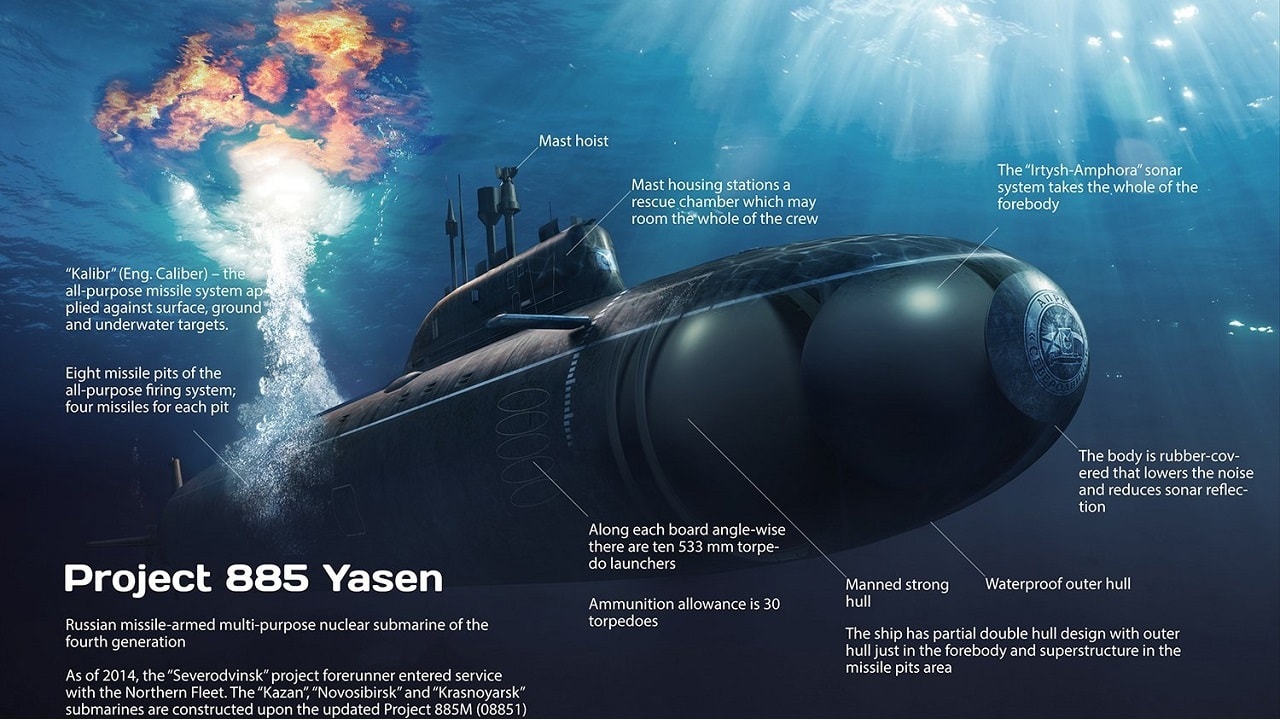Russia’s Yasen-M ballistic missile submarines will fire the Zircon hypersonic cruise missile by 2025 from the ocean, a development marking a potential new era in maritime warfare threats.
The first Yasen-M boat in the class to fire the weapon will be the Perm, a vessel slated for commissioning in 2024, according to Russia’s TASS news service.
“Among the nuclear submarines of project 885M, the fifth submarine Perm will be the first regular carrier of the Zircons, which will be structurally slightly different from its predecessors,” the paper quotes a source saying.
Should the U.S. Navy succeed with plans to fire hypersonic missiles from attack submarines by 2028, something Chief of Naval Operations Adm. Michael Gilday told Congress last year, they might be behind the Russian timeline, should TASS be accurate.
Yasen: A Threat Beneath the Surface
Lurking beneath the surface within striking distance of enemy territory, hypersonic missile-armed submarines would present adversaries with quite an advantage, as they could hit enemy targets on shore while remaining quite difficult to detect by enemy ground or air radar systems. A surface ship or lower-flying aircraft, by contrast, would likely be seen and known by an enemy at great distances, whereas a submarine might succeed in eluding detection and be in a position to launch surprise attacks capable of destroying high-value enemy targets from the ocean within minutes.
Overall, Russia will operate 11 Yasen-class submarines, with 10 being the modern Yasen-M variant. The first Yasen, called the Serverodvinsk, emerged 10 years ago, whereas the first Yasen-M boat, the Kazan, appeared in 2021. Russia recently announced it will build two more as-of-yet-unmanned Yasen-M submarines.
Russian and American Submarines Keep Similar Technologies
The Yasen-M boats are built with a KTP-6 Monoblock life-of-core reactor which, while decreasing size and space, also brings quieting technologies to the submarine. The largest advantage of a life-of-core reactor, which is what is now being built into the U.S. Navy’s emerging Columbia-class boats, is that it enables continued operational service and deployment without having to pause for mid-life refueling.
“The new-generation reactor will also contribute to the quieting of the submarine, meaning that the Kazan may surpass the Severodvinsk in terms of its ability to evade detection,” a Rusi.org essay states.
Yet another advantage woven into the upgraded Yasen-M submarines is its conformal array sonar, which improves performance beyond the “cylindrical array sonar” on most Russian submarines. It is possible that Russian weapons developers copied U.S. Navy conformal array sonar technology built into Block III Virginia-class attack submarines in recent years.
“It allows a larger surface area for hydrophone arrays, and thus greater array gains in passive mode compared to the older spherical array sonar configuration,” Rusi.org states.
Kris Osborn is the Military Affairs Editor of 19FortyFive and President of Warrior Maven – Center for Military Modernization. Osborn previously served at the Pentagon as a Highly Qualified Expert with the Office of the Assistant Secretary of the Army—Acquisition, Logistics & Technology. Osborn has also worked as an anchor and on-air military specialist at national TV networks. He has appeared as a guest military expert on Fox News, MSNBC, The Military Channel, and The History Channel. He also has a Masters Degree in Comparative Literature from Columbia University.

